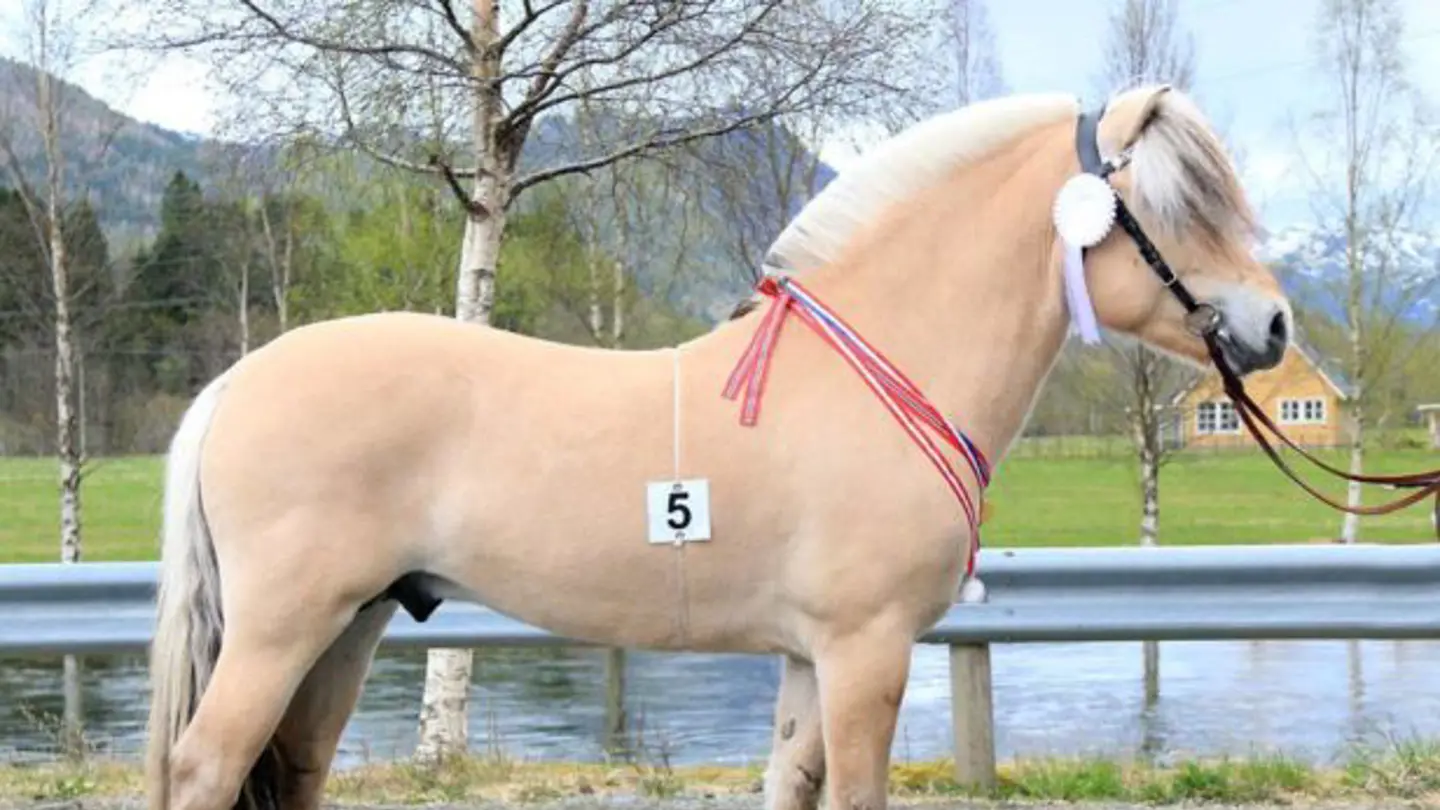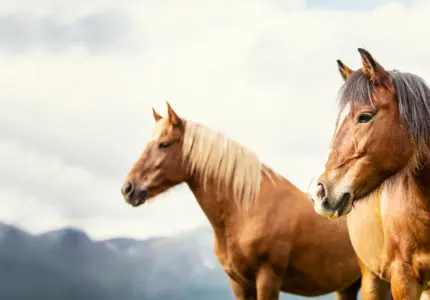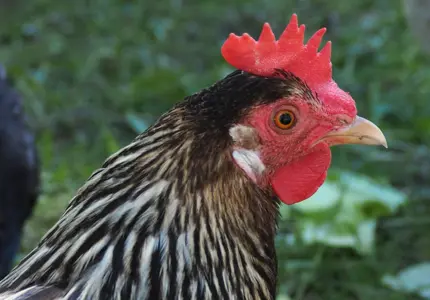
Norwegian Fjord Horse
- Home
- Our work
- Farm animals
- Nordic native breeds
- Norwegian Fjord Horse
Origin: Norway
Native name: Fjordhest
Weight: 400-500 kg
Withers height: 135-150cm
Colour: brown dun, white dun, grey (blue dun), red dun and yellow dun with primitive marking
Type: Light driving and riding horse
FormNumber of offspring: 1
Birth weight: approx. 45 kg
Number of covered mares, 2020: 271, with approximately 150 foals born per year.
Not at Risk – Vulnerable – Enangered – Critically Endangered – Extinct
Background
The Norwegian Fjord horse originates from the fjord areas in western Norway. The Fjord horse is easy to feed, hardy, enduring and sure-footed in the terrain and is therefore adapted to the landscape around it. Throughout the 20th century, the Fjord horse was bred purely on the dun color that is an important breed characteristic today, with primitive marking such as midsole and tail feathers (dark middle part in forehead, mane, and tail), eel (dark stripe along the back) and transverse stripes on the legs. A few have dark transvere stripes over the withers.
Before the 1860s, the road structure in western Norway was poor, and the Fjord, or Vestland horse as it was also called, was responsible for important transport in the mountains and along fjords. In the steep and rugged terrain, this light and steady horse fit well. At the initiative of the Royal Society for the Welfare of Norway (Norges Vel), the first stud book for Fjord horses was published in 1910. The Fjord horse is a versatile horse with many uses. Today it is mainly used as a riding and driving horse in competitions and on a hobby basis, in addition to being used for riding school, in therapy riding and as a work horse. The Fjord horse is the Norwegian national horse breed that has the largest populations outside Norway’s borders in Denmark, Sweden, Belgium, the Netherlands, Germany and the USA. In Norway, there are about 5,800 Fjord horses and an estimated 80 000 Fjord horses worldwide.
The Norwegian Championship (NM) for Fjord Horse is a combined competition where the purpose is to promote versatile use of the Fjord Horse, and it is held every year. The competition consists of various riding and driving exercises, so that the crew’s versatile skills are emphasized. In addition, efforts have been made to promote the young horses with the awarding of the best young Fjord horse – BUF. The NM in Fjord horses was first held in 1986. At the end of the 90s, a so-called NM week was established with extra open classes, which made the competition last over 5-7 days, and today it is a horse festival. The NM in Fjord horses is becoming increasingly popular and has grown to a competition with up to 150 participating teams, with a wide range of exercises, which makes it one of the largest horse competitions in Norway.

Conservation
The Norwegian Ministry of Agriculture and Food (LMD) is the highest authority for all livestock breeding in Norway. The Norwegian Genetic Resource Center was established in 2006 as an advisory and executive body to LMD. The Norwegian Genetic Resource Center coordinates activities within the conservation and use of national genetic resources, and has the task of monitoring status and contributing to the efficient management of the genetic resources in livestock, useful plants and forest trees in Norway. The responsibility for this work on horses is assigned to the Norwegian Horse Center, which has an advisory and executive function for the breeding organizations. The Norwegian Horse Center reports to LMD, and also reports annual key figures to the Norwegian Genetic Resource Center.
In 2011, an action plan was made for national horse breeds that included the Dole horse, Fjord horse and Nordland/Lyngen horse, and a new action plan is out for consultation now (May 2021). The purpose of the action plan is to structure and give direction to the measures that are considered necessary to ensure the management of the breeds and is a management tool for the conservation work on the national breeds. In 2016, LMD established a professional committee for the national horse breeds that will advise LMD on the work with the national horse breeds based on the current action plan for national horse breeds. The subject committee consists of representatives from the breeding organizations, the Norwegian University of Life Sciences, the Norwegian Genetic Resource Center and the Norwegian Horse Center.

The Norwegian Fjord Horse Association (Norges Fjordhestlag) was founded in 1949, and is the responsible breeding organization for the breed. Registration of Fjord horses in the pedigree registry is performed by the Norwegian Horse Center by agreement with the Norwegian Fjord Horse Association. The Norwegian Fjord Horse Center is located on Nordfjordeid and is a Knowledge center for breeding and use of Fjord horses. The center has its own semen station in operation during the breeding season. The Norwegian Fjord Horse Center performs tasks for the Fjord horse in collaboration with Norges Fjordhestlag.
Characterization
Research activities are ongoing, that focus on characterizing the breed. Characterization is an important part of the conservation work as this provides information about the breed has unique characteristics we may need in the future. Since the breed is part of our cultural heritage, it is also important to ensure historical knowledge about its development and significance for humans, as by securing knowledge about the breed we can also ensure knowledge about our own social development.
Based on a systematic study conducted by NordGen, 23 easily accessible studies were found that included the breed until 2019. This makes the Fjord horse the most characterized horse breed in Norway. The majority of the studies focused on molecular genetic diversity within and between Fjord horses and a selection of other breeds. Fjord horses are especially included in studies that investigate molecular genetic diversity between breeds, including studies that deal with the horse’s origins using DNA from mitochondria and genomic relationships with a number of different breeds. The breed has also been included in several studies that have looked at phenotypic traits. These are about morphological variation in body size and body shape, temperament and color genetics. The breed is the only Norwegian horse breed included in a study of its socio-cultural significance by describing the breed’s development. However, there is still a need to characterize the Fjord horse, as there are many characteristics and features that have not been mapped. Acquiring such knowledge will place us stronger in the preservation of the breed.
References
Andersson, L. (2010). Analysis of inbreeding in the Swedish Gotland Pony using pedigree information and microsatellite markers. Swedish University of Agricultural Sciences, available at: http://stud.epsilon.slu.se/8923/7/andersson_l_160322.pdf
Bhatnagar, A. S., East, C. M. & Splan, R. K. (2011). Genetic variability of the Norwegian fjord horse in North America. Animal Genetic Resources 49, 43–49. doi:10.1017/S2078633611000105.
Bjørnstad, G., Gunby, E. & Røed, K. H. (2000). Genetic structure of Norwegian horse breeds. Journal of Animal Breeding and Genetics 117(5), 307–317.
Bjørnstad, G., Nilsen, NØ & Røed, K. H. (2003). Genetic relationship between Mongolian and Norwegian horses? Animal Genetics 34(1), 55–58.
Bjornstad, G. & Roed, K. H. (2002). Evaluation of factors affecting individual assignment precision using microsatellite data from horse breeds and simulated breed crosses. Animal Genetics 33(4), 264–270. doi:10.1046/j.1365-2052.2002.00868.x.
Bjørnstad, G. & Røed, K. H. (2001). Breed demarcation and potential for breed allocation of Horses Assessed by microsatellite markers. Animal Genetics 32(2), 59–65.
Brooks, S. A., Makvandi-Nejad, S., Chu, E., Allen, J. J., Streeter, C., Gu, E., McCleery, B., Murphy, B. A., Bellone, R. & Sutter, N. B. (2010). Morphological variation in the horse: Defining complex traits of body size and shape: Skeletal traits in the horse. Animal Genetics 41(December), 159–165. doi:10.1111/j.1365-2052.2010.02127.x.
Eriksen, T. (2010). The Nordland / Lyngen horse. Thesis, Szent Istvan University, Faculty of Veterinary Science, available at: http://www.huveta.hu/handle/10832/238
Høiseth, M. (2017). Genetisk Variasjon Og Fargegenetikk Hos Fjordhest. n.d. Accessed 24 September 2019, available at: https://nmbu.brage.unit.no/nmbu-xmlui/bitstream/handle/11250/2453484/Masteroppgave20Mia20HC3B8iseth.pdf?sequence=1&isAllowed=y
Jansen, T., Forster, P., Levine, M. A., Oelke, H., Hurles, M., Renfrew, C., Weber, J. & Olek, K. (2002). Mitochondrial DNA and the origins of the domestic horse. Proceedings of the National Academy of Sciences 99(16), 10905–10910.
Kierkegaard, L.S., Groeneveld, L.F., Kettunen, A., Berg, P. (2020). The status and need for characterization of Nordic animal genetic resources, Acta Agriculturae Scandinavica, Section A — Animal Science, 69:1-2, 2-24, DOI: 10.1080/09064702.2020.1722216
Lindgren, G., Backström, N., Swinburne, J., Hellborg, L., Einarsson, A., Sandberg, K., Cothran, G., Vilà, C., Binns, M. & Ellegren, H. (2004). Limited number of patrilines in horse domestication. Nature Genetics 36(4), 335–336.
Olsen, H. F. & Klemetsdal, G. (2010). Management to ensure effective population size in a breeding programme for the small Norwegian horse breeds – a simulation study. Acta Agriculturae Scandinavica, Section A - Animal Science 60(1), 60–63. doi:10.1080/09064700903567799.
Olsen, H. F. & Klemetsdal, G. (2017). Temperament of the Norwegian horse breeds – a questionnaire based study. Applied Animal Behaviour Science 193(August), 60–66. doi:10.1016/j.applanim.2017.03.015.
Petersen, J. L., Mickelson, J. R., Cothran, E. G., Andersson, L. S., Axelsson, J., Bailey, E., Bannasch, D., et al. (2013a). Genetic diversity in the modern horse illustrated from genome-wide SNP data. Edited by Hans Ellegren. PLoS ONE 8(1), e54997. doi:10.1371/journal.pone.0054997.
Petersen, J. L., Mickelson, J. R., Rendahl, A. K., Valberg, S. J., Andersson, L. S., Axelsson, J., Bailey, E., et al. (2013b). Genome-Wide analysis reveals selection for important traits in domestic horse breeds. Edited by Joshua M. Akey. PLoS Genetics 9(1), e1003211. doi:10.1371/journal.pgen.1003211.
Promerová, M., Andersson, L. S., Juras, R., Penedo, M. C. T., Reissmann, M., Tozaki, T., Bellone, R., et al. (2014). Worldwide frequency distribution of the “gait keeper” mutation in the DMRT3 gene. Animal Genetics 45(2), 274–282. doi:10.1111/age.12120.
Selle, T. (2010). Genetisk Analyse Av Utstillingsresultat for Dei Norske Hesterasane Dølehest, Fjordhest Og Nordlandshest/Lyngshest - Genetic Analysis of Show Results for the Norwegian Horse Breeds; the Døle Horse,the Fjord Horse, and the Nordland/Lyngen Pony. Norwegian University of Life Sciences, available at: https://brage.bibsys.no/xmlui/handle/11250/185970
Sild, E., Rooni, K., Värv, S., Røed, K., Popov, R., Kantanen, J. & Viinlass, H. (2019). Genetic diversity of Estonian horse breeds and their genetic affinity to Northern European and some Asian breeds. Livestock Science 220(February), 57–66. doi:10.1016/j.livsci.2018.12.006.
Staiger, E. A., Almén, M. S., Promerová, M., Brooks, S., Cothran, E. G., Imsland, F., Fegraeus, K. J., et al. (2017). The evolutionary history of the DMRT3 “gait keeper” haplotype. Animal Genetics 48(5), 551–559. doi:10.1111/age.12580.
Strøm, L. C. (2010). Breeding and Breed Development of the Norwegian Fjord Horse (Budapest: Szent Istvan University, Faculty of Veterinary Science, Institute of Animal Breeding, Nutrition and Laboratory Animal Science).
Tenhunen, S. (2018). Utilizing shared segments for build-up genomic relationship between the Norwegian and the Swedish Fjord Horse. Accessed 10 December 2019, available at: https://nmbu.brage.unit.no/nmbu-xmlui/bitstream/handle/11250/2570640/Tenhunen2018.pdf?sequence=1&isAllowed=y
Vangen, O. (1983). The use of relationship matrices to avoid inbreeding in small horse populations. Zeitschrift Für Tierzüchtung Und Züchtungsbiologie 100(1–5), 48–54. doi:10.1111/j.1439-0388.1983.tb00711.x.
Vila, C. (2001). Widespread origins of domestic horse lineages. Science 291(5503), 474–477. doi:10.1126/science.291.5503.474.
Read more about our other native breeds
-

Nordland/Lyngen Horse
The first known and documented exhibition where this breed participated, was in 1898 at Lyngseidet in Troms. In the 1930s, organized breeding of Nordland/Lyngen horses started.
Read more about the breed
-

The Nordic brown bee
Honey bees are threatened by intensive agriculture, habitat loss and climate changes worldwide and are important to conserve, not only due to their honey production but also due to their pollination services.
Read more about the breed
-

Finnish Landrace Chicken
In 1974, the agricultural advisory agency collaborated with Seiskari and published a call to find remains of the Finnish landrace chicken. As a result, one flock was found in South-East Finland. This family line was named after its geographical location as “Savitaipaleenkanta”.
Read more about the breed